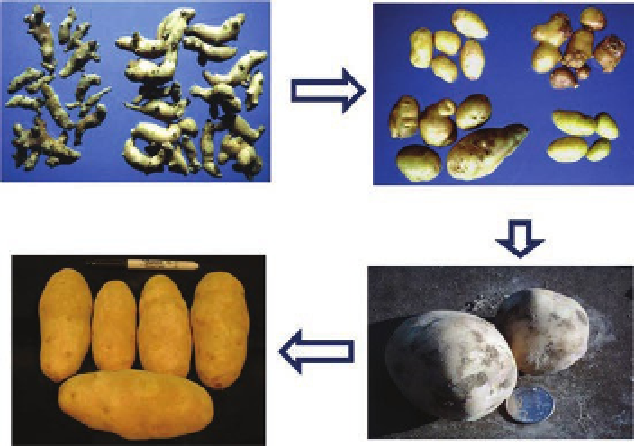Agriculture Reference
In-Depth Information
non-tuber-bearing species that cannot be hybrid-
ized with tetraploid or diploid forms of cultivated
potato. Sexual incompatibilities were overcome
by the use of somatic hybridization with the gen-
eration of somatic hybrids between
S. etuberosum
and a Gp. Tuberosum dihaploid ×
S. berthaultii
hybrid clone (Novy and Helgeson, 1994a). The
tri-species somatic hybrids had very vigorous
foliar growth in the field, with low yields of tubers
having very poor type
(Fig. 16.1
)— not totally un-
expected, with approximately 75% of the gen-
ome originating from wild species.
However, following two generations of hy-
bridization of the somatic hybrids to cultivated
potato, breeding clones having round, white-
skinned tubers with the appearance desired for
use by the chipping industry were obtained
(Fig
of crossing to cultivated potato (four generations
removed from the somatic hybrid progenitors),
breeding clones with the long tuber type and
russeted skin desired by the western US potato
industry also were obtained (
Fig. 16.1
)—indicative
of how species can be used successfully in a
breeding program. The breeding clone with the
long, russeted tubers referenced in
Fig. 16.1
has
potato leaf roll (PLRV) resistance derived from
S. etuberosum
and the necessary processing
attributes for its continued evaluation and ad-
vancement for possible release as a potato culti-
var. In addition to PLRV resistance, the somatic
hybrids and their progenies have been shown to
have resistances to
Potato virus Y
, green peach
aphid, pink rot,
Pythium
leak, and potato psyllid
(Novy and Helgeson, 1994b; Novy
et al
., 2002a,
2007; Thompson
et al
., 2007; Butler
et al
., 2011),
with unpublished data suggesting resistance to
wireworm and Colorado potato beetle as well.
A major gene for PLRV resistance derived from
S. etuberosum
,
Rlretb
, has also been mapped (Gillen
and Novy, 2007; Kelley
et al
., 2009). The numer-
ous resistances identified in the progenies of
S. etuberosum
and
S. berthaultii
highlight the
contributions that wild species can make to the
genetic improvement of potato.
16.3
Emerging Issues of Importance
in Potato Breeding
Potato has a myriad of diseases, pests, and
physiological disorders that are problematic for
its production, the extent of which are detailed
in this volume (see Waters and Jensen, Chapter
9;
Palomares-Rius
et al
., Chapter
10;
Kirk and
Somatic hybrids
1st generation
4th generation
2nd generation
Fig. 16.1.
Tubers of somatic hybrids of
Solanum etuberosum
and a Gp. Tuberosum dihaploid ×
Solanum
berthaultii
hybrid and the improvement in tuber type over generations with successive hybridizations to
cultivated potato.

